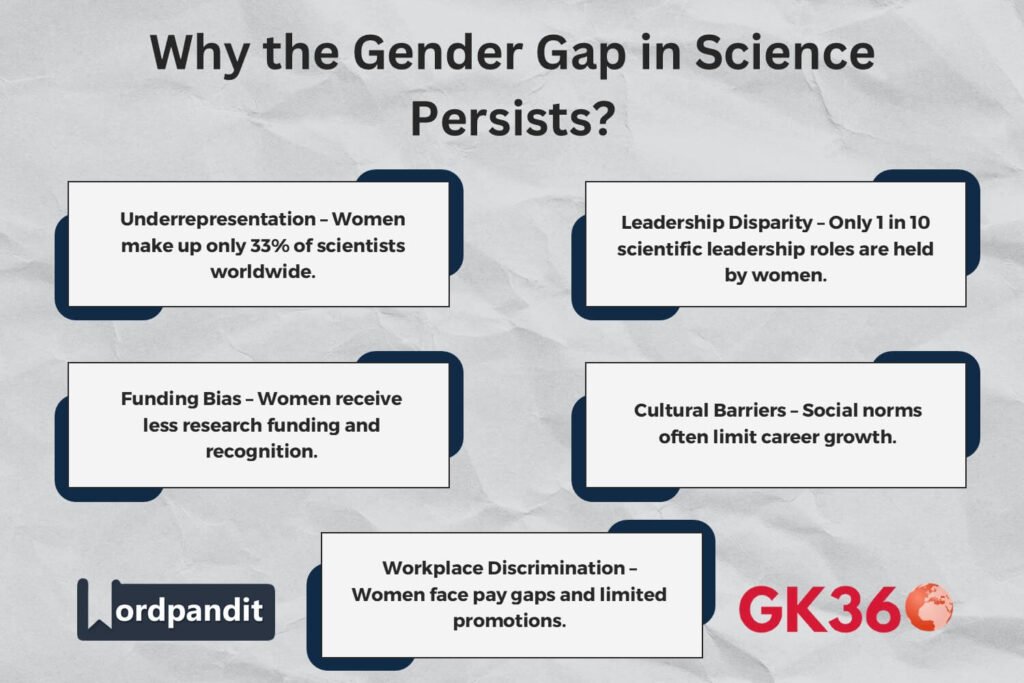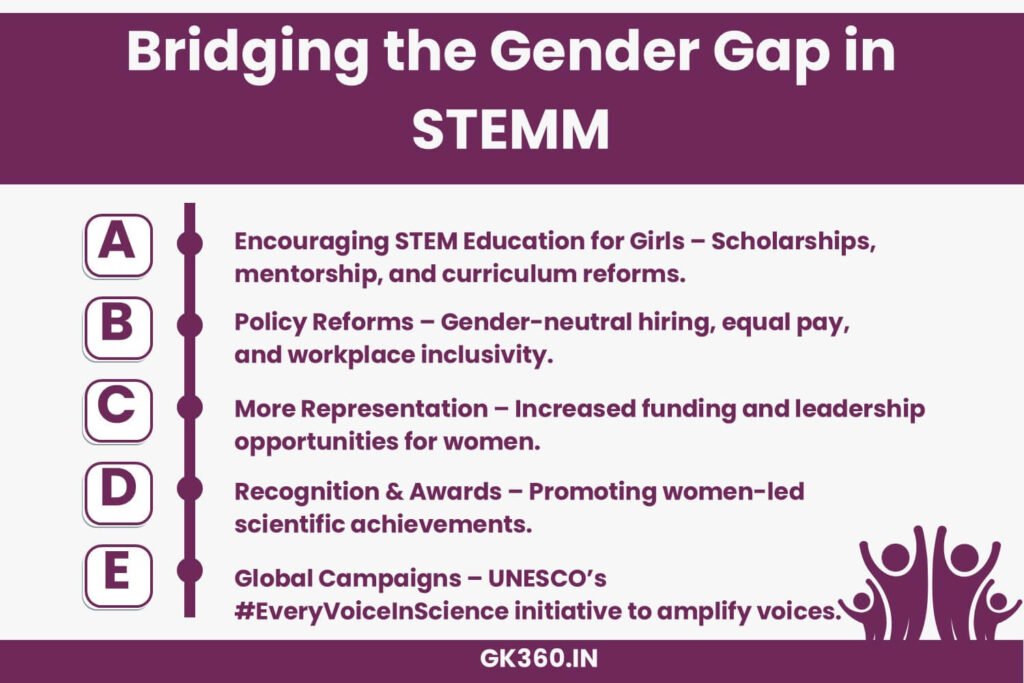Women in Science: UNESCO’s Global Campaign for Gender Equality in STEMM
Introduction: The Need for More Women in STEMM
Despite progress in gender equality, women remain underrepresented in STEMM (Science, Technology, Engineering, Mathematics, and Medicine) fields globally. The barriers range from gender biases to lack of opportunities and leadership roles.
To address these disparities, UNESCO has launched the “Imagine a World with More Women in Science” campaign to mark the 10th anniversary of the International Day of Women and Girls in Science (February 11).
With the hashtag #EveryVoiceInScience, the initiative aims to encourage female participation in STEMM, celebrate their contributions, and push for a more inclusive scientific community.

Table of Contents
- Why the Gender Gap in Science Persists?
- UNESCO’s “Imagine a World with More Women in Science” Campaign
- Global & Indian Perspectives on Gender Disparity in STEMM
- Key Challenges Faced by Women in Science
- Strategies to Bridge the Gender Gap in STEMM
- Why Gender Diversity in Science Matters?
- FAQs: Women in STEM & Gender Equality
- Conclusion & Call to Action
Why the Gender Gap in Science Persists?
The Global Gender Gap in STEMM
- Only 33% of scientists worldwide are women.
- Leadership gap: Just 1 in 10 scientific leadership positions are held by women.
- Gender bias in research funding and awards limits opportunities for female scientists.
India’s Progress & Challenges in STEMM
- 43% of STEMM students in India are women, but only 18.6% of scientists are female.
- Women-led R&D projects account for just 25% of total research initiatives.
- Cultural norms and societal expectations often restrict career growth for women in STEMM fields.
UNESCO’s “Imagine a World with More Women in Science” Campaign
To combat gender disparities in STEMM, UNESCO has launched a global initiative that aims to:
- Inspire young girls to pursue careers in STEMM.
- Showcase female role models in science and research.
- Encourage global policy reforms for gender equality in STEMM.
- Promote the hashtag #EveryVoiceInScience to create a worldwide movement.
This campaign seeks to amplify women’s contributions in STEMM, highlight their achievements, and promote a more inclusive scientific environment.
Key Challenges Faced by Women in Science
1. Gender Stereotypes & Cultural Barriers
- STEMM fields are often perceived as male-dominated.
- Family expectations place additional responsibilities on women, limiting their career opportunities.
- Lack of mentorship prevents young girls from entering STEMM careers.
2. Workplace Discrimination & Leadership Gaps
- Hiring bias: Women face fewer job opportunities in top research positions.
- Pay disparity: Women in STEMM earn less than their male counterparts for similar roles.
- Limited promotion opportunities reduce female leadership in science.
3. Lack of Visible Role Models & Career Progression Barriers
- Few women are recognized in scientific awards or leadership roles.
- Underrepresentation in scientific journals & patents.
- Career breaks (e.g., maternity leave) create setbacks in long-term career growth.
Strategies to Bridge the Gender Gap in STEMM
1. Encouraging STEM Education for Girls
- Revamp school curriculums to include more female scientist role models.
- Offer STEM scholarships for female students to encourage participation.
- Corporate Social Responsibility (CSR) initiatives to fund mentorship programs for girls in STEMM.
2. Policy & Workplace Reforms for Gender Inclusivity
- Implement gender-neutral hiring policies to eliminate biases.
- Ensure equal pay & maternity benefits to support working mothers.
- Promote Diversity, Equity, and Inclusion (DEI) policies in workplaces.
3. Representation & Recognition of Women Scientists
- Increase research funding & grants for women-led projects.
- Establish awards & leadership programs recognizing women in science.
- Use media & social campaigns like #EveryVoiceInScience to amplify female contributions.
Why Gender Diversity in Science Matters?
- Better Innovation & Research Outcomes: Diverse teams bring new perspectives & creative problem-solving.
- Economic Growth: Gender diversity boosts scientific innovation & economic progress.
- Global Challenges: Women in science help address issues like climate change, healthcare, and AI ethics.
- Inspiration for Future Generations: More women in STEMM encourage young girls to pursue science careers.
FAQs: Women in STEM & Gender Equality
1. Why are women underrepresented in STEMM fields?
Women face gender biases, cultural stereotypes, workplace discrimination, and a lack of leadership opportunities in STEMM careers.
2. How can we encourage more women to join STEMM?
By revamping education policies, offering STEM scholarships, promoting mentorship programs, and implementing gender-neutral hiring practices.
3. What is UNESCO’s #EveryVoiceInScience campaign?
It’s a global initiative to amplify women’s voices in STEMM, highlight their contributions, and push for gender-inclusive policies.
4. What challenges do women in science face in India?
In India, women have high STEMM enrollment rates (43%) but low workforce representation (18.6%). Challenges include workplace biases, funding disparities, and career interruptions.
5. How can organizations promote gender inclusivity in science?
By enforcing diversity policies, ensuring equal pay, creating women-led research grants, and promoting female leadership in STEMM organizations.
Conclusion & Call to Action
UNESCO’s “Imagine a World with More Women in Science” campaign is not just about raising awareness—it’s a call for action to dismantle systemic barriers and build a more inclusive, diverse, and innovative scientific community.
Key Takeaways Table
| Aspect | Details |
|---|---|
| Global Gender Gap in STEMM | Women make up only 33% of scientists and hold just 10% of leadership roles. |
| India’s STEMM Landscape | 43% of STEMM students in India are women, but only 18.6% of scientists are female. |
| UNESCO’s Initiative | The “Imagine a World with More Women in Science” campaign promotes women’s participation in STEMM. |
| Challenges Faced by Women | Gender biases, lack of role models, career interruptions, and funding disparities. |
| Strategies for Change | STEM education for girls, workplace reforms, leadership opportunities, and global advocacy. |
| Why Gender Diversity Matters | It boosts innovation, economic growth, and problem-solving in critical fields like healthcare and AI. |
Related Terms:
- Women in STEMM
- Gender Equality in Science
- UNESCO Women in Science
- #EveryVoiceInScience
- STEMM Education for Girls
- Gender Gap in Science
- Women Scientists Recognition
- Diversity in Research
- Female Leadership in STEMM
- Breaking Barriers in Science






